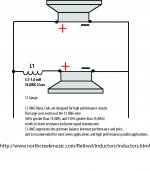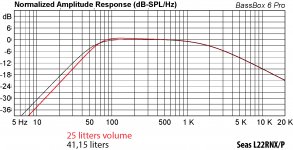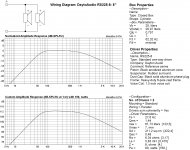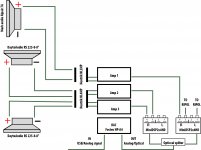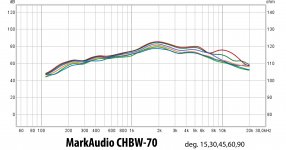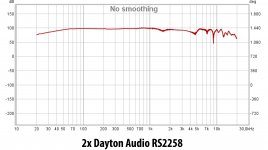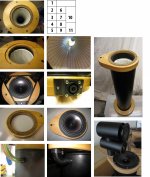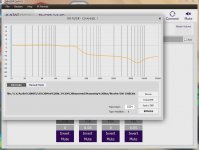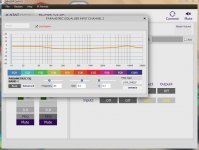Gosh! Have you looked at Linkwitz Lab site? Haha, obviously you have 😉 it's very extensive and varied, there is much there I don't understand and some which I think I do 😱. If there is something in particular you have in mind please say and we'll see what happens, someone will probably have an answer or opinion that could help in all our understanding 🙂
I think what Linkwitz is saying is that the 12" driver will go 4dB higher than the 10" driver with the same excursion
Sensitivity is only part of the picture.
Sensitivity is only part of the picture.
I have difficulty to understand (I'm sure this is because me and my language skills) Mr.Linkwitz writing :
" The 12" driver is capable of 4 dB higher excursion limited SPL because of its larger piston area."
Peerless 12" SLS 830669 has half Space Sensitivity 2.83V/1m-89.8 dB and Peerless 10" 830668 has half Space Sensitivity 2.83V/1m-87.9 dB......
Using my special arithmetical skills I'm getting 1,9 dB different but not 4 dB.
Self sentences contains two statements :
1 statement: " The 12" driver is capable of 4 dB higher excursion...." all this is fine and sentences could end right there.
2 statement :" limited SPL because of its larger piston area" what that saying to me is as a speaker with larger piston area I would have lower SPL (sound pressure level )....Is such statement is true ?
What makes those two statements to stay in the same sentence ?
Or must understand like " The 12" driver is capable of 4 dB higher excursion and that limits SPL because of its larger piston area ?"
Yep... I guess have make a fool of my self 🙂 and in deed have looked at that Lab site.... That was real fun...
and in deed have looked at that Lab site.... That was real fun...
But all that have gave same afterthoughts , we all know as speakers drivers surrounding environment it is extremely important for letting driver do what it was designed to do by engineers. This why same manufactures will give you recommendation on a certain box volume ( closed or vented ) for certain driver.
If we don't have such recommendations we do use software's to get guides , we have BassBox 6 , WinISD,Sealed Designer,Vented Designer and so on.
Off course it is few obvious condition for speakers driver perform badly ( not how engineers designed for driver perform) - pure box design, speaker box outside in a blazing sun in middle of Africa or on opposite hand in Antarctica, under water or speakers driver faces sand storm in a desert....you got an idea..🙂
And if Mr.Linkwitz work will recalculate drivers environment and that will change our fundamental understanding what driver needs to perform at his best ...We just cant trust engineers who designs speaker drivers and software to calculate boxes for drivers and behaver of those.
 and in deed have looked at that Lab site.... That was real fun...
and in deed have looked at that Lab site.... That was real fun...But all that have gave same afterthoughts , we all know as speakers drivers surrounding environment it is extremely important for letting driver do what it was designed to do by engineers. This why same manufactures will give you recommendation on a certain box volume ( closed or vented ) for certain driver.
If we don't have such recommendations we do use software's to get guides , we have BassBox 6 , WinISD,Sealed Designer,Vented Designer and so on.
Off course it is few obvious condition for speakers driver perform badly ( not how engineers designed for driver perform) - pure box design, speaker box outside in a blazing sun in middle of Africa or on opposite hand in Antarctica, under water or speakers driver faces sand storm in a desert....you got an idea..🙂
And if Mr.Linkwitz work will recalculate drivers environment and that will change our fundamental understanding what driver needs to perform at his best ...We just cant trust engineers who designs speaker drivers and software to calculate boxes for drivers and behaver of those.
Last edited:
I think what Linkwitz is saying is that the 12" driver will go 4dB higher than the 10" driver with the same excursion
Sensitivity is only part of the picture.
Thank you Eirik,
Looks like you are right 🙂
Have loaded Seas L22RNX/P data in to BassBox 6 Pro
Red graph- "bass box" was free to choose pipe volume with 2 drivers.
Black graph- 2 drivers in 25 litre pipe.
Have looked at 1 order filter coils and found this
Is it true coil wire gauge will affect sound quantity ?
Red graph- "bass box" was free to choose pipe volume with 2 drivers.
Black graph- 2 drivers in 25 litre pipe.
Have looked at 1 order filter coils and found this
Is it true coil wire gauge will affect sound quantity ?
Attachments
Was playing with BassBox 6 Pro software trying to fit all sort of 8" drivers to existing 25 litter volume enclose. Only one driver fit like a glove ....it was DaytoAudio RS 225-8-8".
Qtc ,using two drivers according to software, is still 0,757.
Speakers sensitivity quite impressive...
And have decided on to avoid using passive crossover...instead will order one more mini DSP 2x4 HD. Reason for avoiding passive crossover is...in the beginning is too many unknowns...precise value of coil, coil type and so on.
With active crossover ..sky is a limit....crossing points, type of filter is just under fingertips. Only then sound satisfactory ,possible to think about passive filter.
Thank you from bottom of my heard everybody for participating.
Happy holidays!
Qtc ,using two drivers according to software, is still 0,757.
Speakers sensitivity quite impressive...
And have decided on to avoid using passive crossover...instead will order one more mini DSP 2x4 HD. Reason for avoiding passive crossover is...in the beginning is too many unknowns...precise value of coil, coil type and so on.
With active crossover ..sky is a limit....crossing points, type of filter is just under fingertips. Only then sound satisfactory ,possible to think about passive filter.
Thank you from bottom of my heard everybody for participating.
Happy holidays!
Attachments
Hello everybody,
Would like to thank each and every one of you who has participated in this thread giving me helping hand to finish LX mini quest. Thank you for sharing know-how and helpful comments.
Have not done without your support and responsibility to finish this project.
Would like to share with forum that I have learned and don’t hasted to ask questions what have slipped my mind like “not important” or “self-explaining”.
Recapture:
Fundament for this project was my deep mistrust of such statements like:
“ …but now the LXmini will exceed what PLUTO 2.1 had to offer and be a true alternative to the LX521, except for the bigger speaker's extended bass.”
or
“ …LXs with studio is a speaker that is on par with the LX521.4 in terms of frequency range, clarity, imaging, sound stage size, dynamics and disappearance, albeit at somewhat lower maximum sound levels in the midrange and above. It is more flexible in room placement and woofer setup. LXstudio provides precise and highly revealing rendering of stereo recordings.”
It is just no way as any two-way loudspeaker will do god enough job to shadow 4 way speaker system as LX 521 are. Add to all this LX mini is quite different design approach compare to LX 521.
Simple logic tells us if one small 5-ich woofer with tiny full range driver does the same job as 6 driver does, so why to waist money and drivers to get slightly better result?
Two-way loudspeaker systems known for having inherited design flows and those are not small things from sound quality and acoustics stand point, they are as serious as a cancer to our body (google it).
I was convinced to tip KEF LS50W vertically take a guts out; equip it with DSP and in combination with woofers such system will outperform LX mini for sure.
Similar thoughts had Bob Katz, old SL (R.I.P.) body since HP era, he redid all SL loudspeaker designs and tray them out in different combinations in a search of perfect reproduction for recorded sound.
Enough with foreplay and let sum what was achieved with my approach to fine tune LX mini`s design.
Mounting mid woofer driver vertically ( 5 or 6 inch drive just can’t reproduce low frequency in closed enclose to be called woofer) was genius SL solution to solve polar response and same of two-way loudspeaker design flows and in combination with full range drive it nearly have solved crossover flow in two way loudspeaker systems.
The problem is nearly –that is not god enough in a search for perfect sound reproduction.
That is driving engine for creativity and colorful approaches to the same problem.
In my approach to LX mini design have ended up with 4 drivers in it:
1. 2x DaytoAudio rs225-8. Two drivers in parallel have solved closed loudspeakers encloses issue (google it) and boosted efficiency close to 100 dB, but left with natural 12dB role off from 60 Hz and excellent sound quality. Crossover at 700 Hz BW 6dB/oct, using only FIR filter.
2. Mid woofer is a MarkAudio CHBW-70. Excellent polar response and natural vocal reproduction. This driver was crustal to end result of versatility of whole loudspeaker. Because it has, natural role off it was easy to combine with tweeter and remain as a two-way loudspeaker in whole.
3. Tweeter Beyma T2030. . Excellent polar response. Efficiency 95dB. Used passive First Order Crossover at 5,5Khz.
This loudspeaker can be used as 4 way, 3 way or 2 way system. 4 and 3 way is not interesting because it is a possibility to go crazy with endless settings and crossover combinations to your liking with DSP.
Most interesting is to remain like original LXmini -2 way loudspeaker and see have this entire job payed off in a sound reproduction quality. So, has is ….? Let me answer with an example, if any of you remember first time you heard serious HIFI system when normally your music enjoyment was thru radio on a table. The same difference is to original LX mini. Sound out of loudspeakers became liberated …bass is a joy, you can hear individual notes, vocalist know can flex vocal without having throat “sore” and pillow on a face. Musical instruments separated and established firm place in 3D picture. Personally, I’m happy with result ,for a wile…..
Would like to thank each and every one of you who has participated in this thread giving me helping hand to finish LX mini quest. Thank you for sharing know-how and helpful comments.
Have not done without your support and responsibility to finish this project.
Would like to share with forum that I have learned and don’t hasted to ask questions what have slipped my mind like “not important” or “self-explaining”.
Recapture:
Fundament for this project was my deep mistrust of such statements like:
“ …but now the LXmini will exceed what PLUTO 2.1 had to offer and be a true alternative to the LX521, except for the bigger speaker's extended bass.”
or
“ …LXs with studio is a speaker that is on par with the LX521.4 in terms of frequency range, clarity, imaging, sound stage size, dynamics and disappearance, albeit at somewhat lower maximum sound levels in the midrange and above. It is more flexible in room placement and woofer setup. LXstudio provides precise and highly revealing rendering of stereo recordings.”
It is just no way as any two-way loudspeaker will do god enough job to shadow 4 way speaker system as LX 521 are. Add to all this LX mini is quite different design approach compare to LX 521.
Simple logic tells us if one small 5-ich woofer with tiny full range driver does the same job as 6 driver does, so why to waist money and drivers to get slightly better result?
Two-way loudspeaker systems known for having inherited design flows and those are not small things from sound quality and acoustics stand point, they are as serious as a cancer to our body (google it).
I was convinced to tip KEF LS50W vertically take a guts out; equip it with DSP and in combination with woofers such system will outperform LX mini for sure.
Similar thoughts had Bob Katz, old SL (R.I.P.) body since HP era, he redid all SL loudspeaker designs and tray them out in different combinations in a search of perfect reproduction for recorded sound.
Enough with foreplay and let sum what was achieved with my approach to fine tune LX mini`s design.
Mounting mid woofer driver vertically ( 5 or 6 inch drive just can’t reproduce low frequency in closed enclose to be called woofer) was genius SL solution to solve polar response and same of two-way loudspeaker design flows and in combination with full range drive it nearly have solved crossover flow in two way loudspeaker systems.
The problem is nearly –that is not god enough in a search for perfect sound reproduction.
That is driving engine for creativity and colorful approaches to the same problem.
In my approach to LX mini design have ended up with 4 drivers in it:
1. 2x DaytoAudio rs225-8. Two drivers in parallel have solved closed loudspeakers encloses issue (google it) and boosted efficiency close to 100 dB, but left with natural 12dB role off from 60 Hz and excellent sound quality. Crossover at 700 Hz BW 6dB/oct, using only FIR filter.
2. Mid woofer is a MarkAudio CHBW-70. Excellent polar response and natural vocal reproduction. This driver was crustal to end result of versatility of whole loudspeaker. Because it has, natural role off it was easy to combine with tweeter and remain as a two-way loudspeaker in whole.
3. Tweeter Beyma T2030. . Excellent polar response. Efficiency 95dB. Used passive First Order Crossover at 5,5Khz.
This loudspeaker can be used as 4 way, 3 way or 2 way system. 4 and 3 way is not interesting because it is a possibility to go crazy with endless settings and crossover combinations to your liking with DSP.
Most interesting is to remain like original LXmini -2 way loudspeaker and see have this entire job payed off in a sound reproduction quality. So, has is ….? Let me answer with an example, if any of you remember first time you heard serious HIFI system when normally your music enjoyment was thru radio on a table. The same difference is to original LX mini. Sound out of loudspeakers became liberated …bass is a joy, you can hear individual notes, vocalist know can flex vocal without having throat “sore” and pillow on a face. Musical instruments separated and established firm place in 3D picture. Personally, I’m happy with result ,for a wile…..
Attachments
Last edited:
Nice job Gin! Thanks for sharing.
I’m going to try a variant on the mini using this woofer
Peerless GBS-135F25AL02-04 5-1/4" Aluminum Cone Woofer 4 Ohm
Rising bass response should offset the loss from a lack of baffle reinforcement and the excellent off axis response all the way to the peak should work well. I plan to use the SBAcoustics 2.5” fullrange instead and ‘bounce’ the wave off of the Peerless dome woofer. Interesting if nothing else!
I’m going to try a variant on the mini using this woofer
Peerless GBS-135F25AL02-04 5-1/4" Aluminum Cone Woofer 4 Ohm
Rising bass response should offset the loss from a lack of baffle reinforcement and the excellent off axis response all the way to the peak should work well. I plan to use the SBAcoustics 2.5” fullrange instead and ‘bounce’ the wave off of the Peerless dome woofer. Interesting if nothing else!
Nice job Gin! Thanks for sharing.
I’m going to try a variant on the mini using this woofer
Peerless GBS-135F25AL02-04 5-1/4" Aluminum Cone Woofer 4 Ohm
Rising bass response should offset the loss from a lack of baffle reinforcement and the excellent off axis response all the way to the peak should work well. I plan to use the SBAcoustics 2.5” fullrange instead and ‘bounce’ the wave off of the Peerless dome woofer. Interesting if nothing else!
Thank you mayhem,
i would like to think about mini as loudspeaker for reproducing excellent mid range and high sound frequency ,but definitely not for low frequency's. It is forcing small drive in closed enclose do job against physics. All closed enclose loudspeaker design has natural role off at 60Hz at LR12dB/oct.
When speaker is forced to produce same where in 30 Hz-50 Hz range....bass became muddy,bummy not musical at all.
If you are going to use a pipe ,please do in larger volume and with two woofers...trust me you will be happy with such designation.Second driver will help first one to do god job and reduce stress on it.
Give a thought about implementing small tweeter ,what will help full range driver tremendously ,so that will let you to play with crossover in regions of 300 Hz and up...
Best of luck with a project
Last edited:
Dear Gin,
Your design looks very interesting, but having already built a pair of Lxmini as per SL spec, do you think I can reuse the original drivers? Thank you, carlo
Your design looks very interesting, but having already built a pair of Lxmini as per SL spec, do you think I can reuse the original drivers? Thank you, carlo
Dear Gin,
Your design looks very interesting, but having already built a pair of Lxmini as per SL spec, do you think I can reuse the original drivers? Thank you, carlo
I did had original driver ,please take a look at post #1 and you will see enclose form original lx mini with was reused to accommodate better driver for a job that was Dayton Audio 6" reference paper woofer RS150P4 and full range was Markaudio Alpair 5.
At same point SL have send me filters for miniDSP 2x4HD,originally lx mini filters was made for miniDSP2x4 with no FIR function.
LS filter version for miniDSP 2x4HD haven't used FIR function and remained such up to the end,
That bother me enormously...is the same like to use a horse for pulling brand new Ferrari.
FIR filter is crucial tool for linear speaker phase what results to to sound quality.
Last edited:
noone did FIR for linkwitz speakers because they realized its nonsense. it only works in an ideal situation on-axis.
its not needed in practice.
its not needed in practice.
noone did FIR for linkwitz speakers because they realized its nonsense. it only works in an ideal situation on-axis.
its not needed in practice.
Are you saying FIR filter it is nonsense?
To be on the same lever and be ready for discussion what FIR filters are,lets start there.🙂 And there....
Correction and implementation a linear-phase loudspeaker crossover it is as far as it gets from nonsense.
All of us use huge amount of time to improve our HIFI even with in smallest margin and if we have succeeded -happy to share in this forum and discus it. So, even smallest victory is a victory....
Last edited:
FIR filters as crossovers have their issues. See for example a whitepaper from Grimm audio,
http://www.grimmaudio.com/site/assets/files/1088/speakers.pdf, explaing in some detail the mix IIR crossovers and FIR phase correction to get a proper result.
http://www.grimmaudio.com/site/assets/files/1088/speakers.pdf, explaing in some detail the mix IIR crossovers and FIR phase correction to get a proper result.
FIR filters as crossovers have their issues. See for example a whitepaper from Grimm audio,
http://www.grimmaudio.com/site/assets/files/1088/speakers.pdf, explaing in some detail the mix IIR crossovers and FIR phase correction to get a proper result.
Interesting read.
FIR filters as crossovers have their issues. See for example a whitepaper from Grimm audio,
http://www.grimmaudio.com/site/assets/files/1088/speakers.pdf, explaing in some detail the mix IIR crossovers and FIR phase correction to get a proper result.
I think that this combination of IIR (for filtering) and FIR (for delay equalization only) is a good approach. Without delay equalization higher order filters will have a peak in the group delay and this can easily become audible. A carefully designed FIR delay equalization filter placed before the crossover network can flatten the group delay across the audio band. This combination makes it more practical to use high order IIR filters in the crossover. You can do both the IIR and FIR filtering in hardware or software based DSPs.
Thank you, ,FIR filters as crossovers have their issues. See for example a whitepaper from Grimm audio,
http://www.grimmaudio.com/site/assets/files/1088/speakers.pdf, explaing in some detail the mix IIR crossovers and FIR phase correction to get a proper result.
beautiful peace of information,fantastic read.
With out knowing that I have ended up with a mix FIR and IIR filters anyway...🙂 what a coincidences !!!
Did that because sounded wright

Attachments
- Home
- Loudspeakers
- Multi-Way
- LX mini quest
